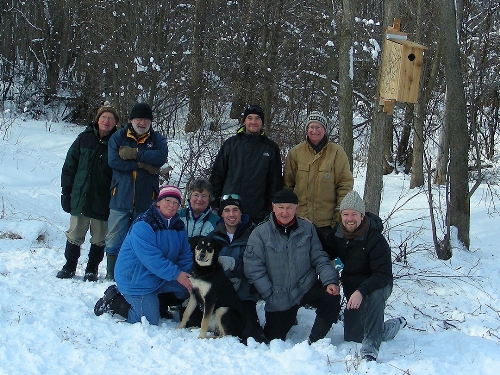Welcome
to the McGill Bird Observatory weekly report.
Click here for a complete listing of our archives.
Comments or
questions are welcome at "mbo AT migrationresearch.org".
|
PICTURE
OF THE MONTH: |
|

This Chipping Sparrow banded on February 23 is easily one of our biggest ever winter
surprises, given that we have no previous observations during the season, and the
earliest spring arrivals typically do not return until mid-April.
(Photo by Gay Gruner)

|
MBO
gratefully acknowledges the in-kind support provided for winter 2011-2012 by CCFA (Centre de Conservation de la Faune Ailée) in Montreal, in the form of bird seed to keep the MBO feeders stocked throughout the season.
|
|
|
|
THIS MONTH |
THIS WINTER |
2012 TOTAL |
SITE TOTAL |
|
# birds (and species) banded |
26 (8) |
331 (17) |
26 (8) |
35777 (108) |
|
# birds (and species) repeat |
1 (1) |
145 (8) |
1 (1) |
6414 (68) |
|
# birds (and species) return |
5 (4) |
26 (5) |
5 (4) |
966 (37) |
|
# species observed |
18 |
45 |
22 |
204 |
|
# net hours |
15.0 |
267.0 |
15.0 |
59114.2 |
|
# birds banded / 100 net hours |
173.3 |
124.0 |
173.3 |
60.5 |
|
|
Note: table does not include nocturnal banding (owls) |
|
Banders-in-charge: Simon Duval, Gay Gruner
Assistants: Emily Board, Dan Brisebois, Chris Cloutier, Jean Demers, Nicole Doucet, Alison Hackney, Malcolm Johnson, James Junda, Barbara MacDuff, Mariner Palmer, George Panciuk, Clémence Soulard, Chick Taylor, Geoffrey Webster, Ryan Young
Notes: Winter conditions still limited our activities somewhat in February, but the weather eased up enough to let us fit in our first banding session of 2012 and two important site maintenance projects. Under beautiful sunny skies on February 15, a great team effort helped us get the cattails on Stoneycroft Pond back under control. Although it is a native plant, it expands aggressively, and without us cutting it back every couple of years, we would soon end up with the pond covered in cattails from one side to the other, significantly affecting its availability for species that require patches of open water. Since our primary objective at MBO is migration monitoring, it is critical that we maintain the consistency of habitat features as much as we can, so that we can be confident that any trends we detect reflect changes in populations rather than the suitability of our site. Cutting and removing the cattails is hard work, and we very much appreciate all the volunteers who came out to help share the load! Later in the month, another team of volunteers came together to assist with cleaning out and repairing our existing collection of Tree Swallow and Wood Duck nest boxes, and to erect some additional Wood Duck boxes donated by George Panciuk and the city of Ste-Anne-de-Bellevue. We still have another four weeks until our Spring Migration Monitoring Program kicks off for an eighth year, but it's always nice to have a good head start on preparations.
This month’s top 10 [previous month's rank in brackets]
# individuals banded |
mean # individuals observed daily |
1. Black-capped Chickadee (7) [7] |
1. American Robin (26) [9] |
1. Slate-colored Junco (7) [3] |
2. American Crow (10) [6] |
3. American Goldfinch (4) [1] |
3. Black-capped Chickadee (9) [7] |
4. Downy Woodpecker (2) [-] |
4. European Starling (7) [1] |
4. Blue Jay (2) [6] |
5. Mourning Dove (6) [-] |
4. American Tree Sparrow (2) [8] |
5. Blue Jay (6) [5] |
7. Hairy Woodpecker (1) [-] |
7. Slate-colored Junco (5) [4] |
7. Chipping Sparrow (1) [-] |
8. American Tree Sparrow (4) [-] |
| |
9. American Goldfinch (3) [8] |
| |
10. Red-tailed Hawk (2) [-] |
|
The list of species banded reflects a single morning of effort on February 23. As noted in the caption for the photo of the month, the Chipping Sparrow was the big suprise, but the two woodpecker species were also banded for the first time this winter. After banding just 4 Black-capped Chickadees earlier this winter, we had 7 on this one day, suggesting that they may be moving around to some extent over the course of winter. We also had another 7 Slate-colored Juncos, but the finch bonanza from early winter has largely dried up, with just 4 more American Goldfinches this month, and no House Finches.
It has been a good winter for American Robins, but even so, seeing them on top of the list of species observed for February is quite a surprise (and especially considering the large margin over all other species). Their dominance is largely attributable to a significant count of 70 on February 23, perhaps representing an early wave of migrants. New species in the top ten this month were Mourning Dove, American Tree Sparrow, and Red-tailed Hawk, while Cedar Waxwing, House Finch, and Northern Cardinal dropped out. Compared to earlier in winter, the scarcity of Northern Cardinals and House Finches is quite a drastic change, although with House Finches at least, we are used to House Finch numbers dropping substantially in the new year most winters, even though the reasons behind that are not at all apparent. This month we only observed one House Finch on February 17, making us wonder where they have all gone. Thanks to our colour banding project and reports from Alison Hackney, we know that at least 13 of them visited her feeder in Senneville over the course of the month, so some at least have not moved far from MBO. Of course that leaves many others unaccounted for, and we hope that other observers will be able to give us updates on their locations using our reporting form.
|

The team of volunteers posing beside one of the new Wood Duck nest boxes at the end of our annual nest box maintenance day - thanks to all for helping with this important task!
|



